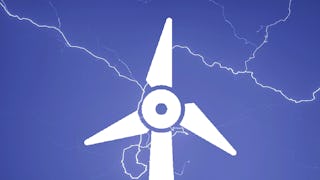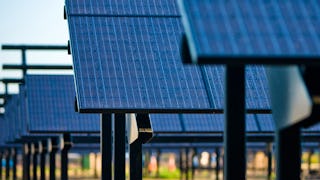What do you picture when you hear the term “renewable energy?” Do you imagine fields of solar panels, giant windmills, or huge hydroelectric dams? Those are all examples of large-scale, grid-tied systems. In this course, we’ll go much smaller and focus on off-grid, stand-alone systems.

Unlock access to 10,000+ courses with Coursera Plus. Start 7-Day free trial.

Exploring Renewable Energy Schemes

Instructor: Jorge Santiago-Aviles
32,040 already enrolled
Included with
(659 reviews)
What you'll learn
Identify the essential characteristics and technical requirements of photovoltaic, wind, and low head hydroelectric energy systems.
Integrate scientific and technological principles necessary to assess and implement small-scale renewable energy schemes.
Develop a plan for implementing a small-scale renewable energy scheme.
Skills you'll gain
Details to know

Add to your LinkedIn profile
See how employees at top companies are mastering in-demand skills

There are 6 modules in this course
In this module, we’ll get started by getting familiar with the course and our community expectations. Then, we'll explore the solar spectrum, the Stefan Boltzmann Law, and Wien’s Displacement Law. Each plays a significant role in helping us capture as much energy as we can from the sun. We’ll also explore direct beam and diffuse radiation and consider the implications for solar panel orientation.
What's included
5 videos11 readings2 assignments1 discussion prompt
In this module, we’ll explore the essential element of any photovoltaic system: the solar cell. We’ll examine all aspects of the solar cell, moving from the single cell to a collection of cells that allow us to harness the sun’s power.
What's included
5 videos2 readings3 assignments1 discussion prompt
The charge controller is a key element of any simple photovoltaic system. This device helps you avoid over or under charging your battery or battery bank. In this module, we’ll focus on both charge controllers and inverters and their important role in photovoltaic systems.
What's included
3 videos4 readings2 assignments1 discussion prompt
In this module, we’ll start thinking about how to design a simple photovoltaic system. We’ll examine efficiency and develop strategies for determining the right components to meet our energy needs.
What's included
6 videos5 readings2 assignments1 discussion prompt
Humans have been harnessing the wind’s power for centuries. We’ve used it to help us sail ships, pump water, and grind gain. In modern times, we’re using wind energy to power our homes. The state of California, a pioneer in wind energy utilization, produces energy from its wind turbine farms in excess of 20 terawatts annually. That’s enough energy to power 3 million households.
What's included
5 videos3 readings2 assignments1 discussion prompt
In this module, we’ll explore the ways water can generate electricity and discuss the components of low-head hydroelectric systems.
What's included
4 videos4 readings2 assignments1 peer review1 discussion prompt
Instructor

Offered by
Explore more from Environmental Science and Sustainability
 Status: Free Trial
Status: Free TrialUniversity of Colorado Boulder
 Status: Free Trial
Status: Free TrialUniversity of Colorado Boulder
 Status: Free Trial
Status: Free TrialL&T EduTech
 Status: Free Trial
Status: Free TrialUniversity at Buffalo
Why people choose Coursera for their career




Learner reviews
659 reviews
- 5 stars
79.66%
- 4 stars
17.14%
- 3 stars
1.97%
- 2 stars
0.60%
- 1 star
0.60%
Showing 3 of 659
Reviewed on Oct 30, 2020
The course was very useful. As a renewable energy engineer, it has strengthened my knowledge. I have recommended it to my fellows.
Reviewed on Sep 14, 2021
Provided a clear explanation of the components and design requirements of an off grid system. Do hope research and development in urban/residential sites will be expanded upon.
Reviewed on May 22, 2020
Exploring Renewable Energy Schemes, That is very helpful, I'm very glad to join in this experience with a team of Coursera, many thanks for all of you.

Open new doors with Coursera Plus
Unlimited access to 10,000+ world-class courses, hands-on projects, and job-ready certificate programs - all included in your subscription
Advance your career with an online degree
Earn a degree from world-class universities - 100% online
Join over 3,400 global companies that choose Coursera for Business
Upskill your employees to excel in the digital economy
Frequently asked questions
To access the course materials, assignments and to earn a Certificate, you will need to purchase the Certificate experience when you enroll in a course. You can try a Free Trial instead, or apply for Financial Aid. The course may offer 'Full Course, No Certificate' instead. This option lets you see all course materials, submit required assessments, and get a final grade. This also means that you will not be able to purchase a Certificate experience.
When you purchase a Certificate you get access to all course materials, including graded assignments. Upon completing the course, your electronic Certificate will be added to your Accomplishments page - from there, you can print your Certificate or add it to your LinkedIn profile.
Yes. In select learning programs, you can apply for financial aid or a scholarship if you can’t afford the enrollment fee. If fin aid or scholarship is available for your learning program selection, you’ll find a link to apply on the description page.
More questions
Financial aid available,
¹ Some assignments in this course are AI-graded. For these assignments, your data will be used in accordance with Coursera's Privacy Notice.

